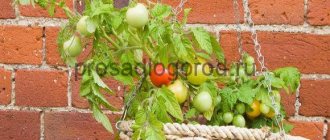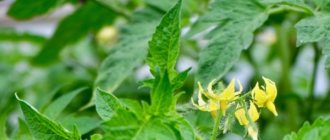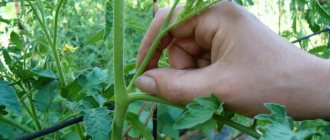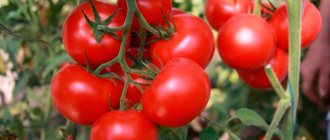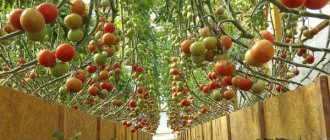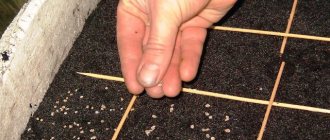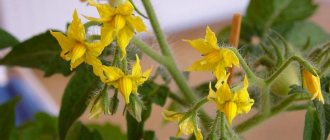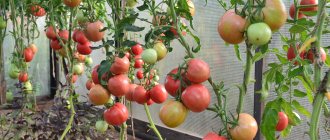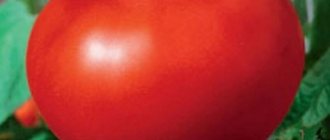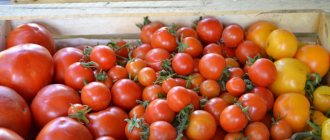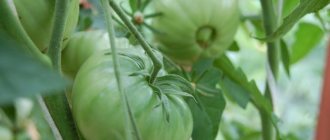What is stepsoning and why is it needed?
Stepchildren are lateral shoots on the tomato stem, growing from the leaf axil. These shoots need nutrition, just like flower and fruiting racemes. And they take away this food to the detriment of the latter.
The process of removing such sprouts is called pinching . By removing them, you help the plant direct all the juices to the formation and ripening of fruits. Simply put, if you ignore this process, you risk being left without a harvest. Pruning, as well as mulching tomatoes in a greenhouse, will help extend the fruiting period, increase the yield per unit area, and get an early harvest.
Almost all types of tomatoes require pinching . The exception is standard varieties - a type of determinant.
These are, as they say, tomatoes for the lazy. They do not require either bush formation, tying, or pinching.
They have a short – up to 50 cm – strong thick stem and their growth is limited by the formation of 3-5 fruiting clusters.
They are planted in open ground, preferably in warm regions, where they will have time to produce fruits of technical ripeness.
Growing and proper care of tomatoes in a greenhouse
Pinching shoots, of course, is an important process for increasing productivity, and this requires appropriate care for tomatoes, but proper and timely feeding of the plant during growth is also important. The simplest recipe for feeding tomatoes in a greenhouse is chicken manure (1 part) and water (13 parts). The frequency of feeding is approximately once every 3 weeks. Approximately 1 liter of solution per 1 plant. This is quite enough.
And it is the creation of one stem, when growing tall tomatoes, that significantly extends the period of fruiting and obtaining a guaranteed harvest within 4 months. Sometimes after stepsoning, from the same point, even in the absence of a leaf, stepsons still appear - this happens. They just need to be broken off.
Photo
In the photo below you can see how to plant tomatoes in a greenhouse correctly:
The need for stepsons
As they develop, shoots called shoots regularly grow on tomato bushes. Their starting point is the leaf sinuses. Their peculiarity is their high growth rate, since for their development they take away the plant’s strength, which is necessary for fruiting. As a result, the bush becomes excessively dense and produces small fruits with a poor taste.
Therefore, for the correct formation of tomato plants, a pinching procedure is carried out. It consists of removing excess shoots. Breaking off the shoots does not harm the plant, but promotes productivity. Ovaries and fruits can also form on such shoots. But they are much smaller in size than real tomatoes. The taste is also far from varietal tomatoes. In addition, such fruits spoil quickly.
Correctly carried out stepsoning allows you to achieve:
- increasing the viability of tomatoes;
- extending the fruiting period;
- formation of the plant skeleton;
- reducing the time of formation of the first fruits.
Despite all the benefits of the procedure, not all varieties of tomatoes need pinching. Tall varieties are grown in one, less often in two, trunks. Therefore, removing excess shoots for such plants is a mandatory procedure. It is not necessary to plant varieties that are small in height. Usually, when grown in the warm southern region, this procedure is abandoned, and in the central part of the country and in the north the bushes are formed into 4 or 5 stems.
Important! Some novice gardeners refuse pinching, believing that a lush, spreading bush will produce more fruit. This leads to the fact that the crop grows small and in small quantities. Sometimes such bushes do not form an ovary at all. The reason is that the plant spends all its energy on growing green mass.
The difference between a leaf and a stepson is in their location. The leaf appears first on the stem. Then the stepson reaches up from the same point. It turns out that it is located above the petiole of the leaf. Therefore, the upper process is always broken off.
Time for stepsoning
start when the first stepson is formed under the first flower cluster. Don't let it grow more than 5 cm, otherwise it will have time to take away precious food. In addition, an overgrown stepson is difficult to remove without damaging the stem, and this can cause bush disease. In order not to miss its appearance, tomatoes should be inspected regularly.
Pruning is best done in the morning with good ventilation and natural light. The weather should be warm and dry. Always start with the strongest and healthiest bushes.
Leave weak bushes or those with suspected damage for last. The optimal frequency of removing stepchildren is once every 7-10 days.
Common mistakes when pinching
What should not be done when planting, so as not to harm the plants:
- Stepsoning is rare and irregular. This requires plants to spend a lot of money on recovery. In addition, time and nutrients have already been spent on the growth of the tops, and not on the ovaries.
- Remove fruiting shoots instead of stepsons. If the shoot comes directly from the stem and inflorescences form on it, then this is a fruitful branch.
- Use dirty garden tools. Before pinching and after processing each bush, they need to be disinfected, for example, with a 1% solution of potassium permanganate or bleach. Therefore, experienced gardeners pluck off excess shoots by hand - this is faster and more efficient.
- Carry out pinching in the evening or in cloudy, damp weather. At this time, the growing season slows down. Wounds resulting from the removal of shoots will take longer to heal, and the risk of contracting diseases will increase.
How to properly step-son?
It is not advisable to use a tool to remove side shoots. This can provoke viral tomato diseases. Stepping is done only by hand. Many people have a question: how to pick off the shoots of tomatoes in a greenhouse?
Grabbing the sprout from above with two fingers, you just need to pinch it. Be sure to leave a stump up to 3 cm long, then a new stepson will not appear in this place. Under no circumstances should you pull the stepson down, trying to break it off. This can strip off part of the stem and cause great harm to the plant.
Important! When pinching the shoot, make sure that the plant juice does not get on your hands. It is with it that “tomato” infections are transferred from one plant to another.
What is the procedure
The formation of bushes is the regulation of the growth of leaves and stems. To direct the plant’s forces to generate fruits, it is recommended to leave no more than three stems and eight flower clusters on one plant.
Advice. To obtain an earlier harvest, leave no more than three fruit clusters on the bushes and pinch the tops. In this case, the fruit begins to ripen and growth stops.
Formation of tomato bushes in a greenhouse: stages of work
The formation of tomato bushes consists of several stages:
- Pinching is the removal of excess shoots, limiting the growth of green mass and allowing the selected shape to be maintained in one, two or three stems.
- Pinching the top , which stops the growth of the bush and directs the plant’s forces to ripening the fruits.
- Trimming lower wilting leaves after fruit formation to protect against fungal diseases.
The first pinching is carried out 2-2.5 weeks after planting the seedlings. You should adhere to the general rules of stepsoning:
- Inspect the tomato bushes and mark all the stepsons for removal to form them into one stem. In a two-stem scheme, leave one of the most powerful shoots located under the first brush; shoots from the second stem must be removed according to the same rules as on the main one.
- Stepchildren are removed by carefully breaking them off from the bush. To prevent branches from growing back in the same place, leave a small shoot 1-2 cm long.
- All removed shoots are collected in a container and taken out of the greenhouse.
Stepping is repeated step by step once every 6-7 days.
Pinching Instructions
The tops of tomatoes are pinched at the end of July - beginning of August, when the required number of inflorescences have formed on the bush.
Carefully pinch off the stem above the last inflorescence that appears, leaving 1-2 leaves on top. Tall varieties are pinched all season long.
Tomatoes in a greenhouse forming a bush
All types of tomatoes need bush formation. Depending on the purpose, the bush is formed into one, two or three stems. Growing tomatoes in a greenhouse scheme:
Formation into 1 stem
In a greenhouse, it is preferable to form a tomato into 1 stem. There will be no thickening with unnecessary branches, which will ensure good penetration of light and air between the bushes.
The formation pattern is as follows: as soon as the first flowering brush has formed, a stepson begins to grow under it. It must be removed in a timely manner.
At the same time, you need to remove the lower leaves; they have already played their role and are no longer needed by the plant. Removing the lower leaves will promote better ventilation of the bushes from below.
Advice: do not throw away these leaves, but put them right there, under the bush, mixed with dried weeds and mown grass. Soon they will begin to decompose and release the carbon dioxide the plant needs.
In the future, mercilessly break off all the lateral shoots that will appear on the stem, leaving only flowering clusters. With this formation, the bush can produce up to 50 fruiting clusters. Forming a bush into 1 stem will prolong the fruiting period.
Formation into 2 stems
with 2 stems is formed as follows: leave only one, the strongest stepson, located under the first flowering brush.
All leaves and side shoots growing below are removed. During the entire period of tomato growth, the stepsons regularly break off.
Formation into 3 stems
A 3-stem bush is formed by removing all but two stepsons. The first is located under the first flowering brush, the second, as a rule, grows above the first stepson.
In 2 stems
The principle of the technique is to determine the main stem and isolate the first stepson (it is the strongest and is capable of active development and fruiting). The latter is easy to identify: it is located under the first flowering brush. They plant a bush into two stems like this:
- all side shoots and leaves growing below the main stepson are removed;
- throughout the entire period of tomato growth, the stepsons need to be regularly broken off;
- in order not to damage the main shoot, it is better to move the sprout when jerking to the side, and not away from you (pruning with a sharp tool is also possible).
Formation of determinate tomato varieties
Features of the formation of different varieties of tomatoes
All tomatoes are divided into three types - determinate, semi-determinate and indeterminate. Determinate varieties complete their growth after setting 4-5 flowering clusters. Semi-determinate varieties can end at any time, or they can continue to grow. Indeterminate varieties have unlimited growth.
Formation of indeterminate varieties
Such varieties are always formed into 1 stem. Many gardeners prefer to form 2 stems to increase yield. But this is everyone's choice.
Forming an indeterminate into two stems is justified in large greenhouses, where tomato bushes can be planted at a greater distance from each other so that they get enough light.
The second stem is formed from a stepson growing under the first flowering brush, and no more than 4-5 flowering brushes are left on it. The remaining shoots are removed.
Formation of semi-determinate varieties
It is difficult to predict whether the plant will stop growing after the formation of several fruiting clusters or not.
Therefore, a second, spare stem is always formed for it. If the main one ends, the backup one will produce fruits.
In the future, if the main stem is not completed after the formation of 6-8 fruiting clusters, the spare stem can be carefully removed so that it does not draw back nutrition.
Formation of determinant varieties
Sometimes low-growing determinate varieties do not form at all. But if you want to get an early harvest from them, the bush can be formed into 1 stem.
For this, no more than 4 inflorescences are left, the rest are removed along with the stepsons. A few leaves are left above the upper inflorescence and the growing point of the plant is pinched.
In this case, the harvest can be harvested two weeks earlier than usual. Recommendations for the formation of determinate varieties are always indicated on the seed package.
Without labor it is impossible to grow a decent harvest. Therefore, you should not neglect such a procedure as caring for tomatoes in a greenhouse, pinching. Your work will pay off in spades when you enjoy opening jars of canned goods in winter.
Why do you need to plant tomatoes?
Tomato is an unpretentious crop, but to get an excellent harvest you need to know some secrets of agricultural technology. As the bushes grow, they quickly form stepchildren, which are always located in the axils between the leaves and stems. They take away nutrients. If they are not removed in a timely manner, the plantings will be thickened and the fruits will be small. The tomato bushes will give all the juices to the development of shoots.
The shoots are located between the stem and the leaf
The fruits are set on the stepsons, but they are much smaller than varietal tomatoes, have a slightly different taste and spoil quickly. On the upper shoots, tomatoes set late and do not ripen on time. Taking into account all these factors, excess shoots must be removed in a timely manner.
Tall tomatoes grown in 1-2 trunks must be pinched. Low-growing determinants do not need to be thinned out. The region where the crop grows is also of great importance. Tomatoes grown in cold regions require more careful planting.
Cherry tomatoes tend to form many shoots that need to be removed quite often. The exception is standard low-growing cherries. They are almost never taken care of.
Features of pinching different types of tomatoes
Different varieties of tomatoes grow differently.
Indeterminate varieties
These varieties include tomatoes with unlimited growth. They can grow up to 2m or more. Other features: long fruiting period (until November), high yield, high resistance to disease.
IMPORTANT: Mandatory conditions for growing tomatoes with unlimited growth are tying them to pre-prepared trellises and abundant watering.
Examples of varieties:
- Shaman;
- Miracle of the Earth;
- Wild Rose.
Indeterminate plants form a single stem, which helps save space in the greenhouse. Also, single-stem molding allows you to get the largest possible fruits.
Along with pinching, they practice gradual removal of the lower leaves (no more than 3 per week to avoid stress). Thus, when the first green tomatoes form on the bush, not a single extra leaf or stem remains on it to interfere with growth, and all the nutrients go into the development of the fruit. Also, the single-stem form improves air circulation in the greenhouse.
At the end of flowering, pinch the top of the bush, remove flower clusters and weak fruits so that the remaining ones receive maximum nutrition.
Semi-determinate varieties
A medium-sized type of tomato with a stem height of 1 to 2 m. They are distinguished by early ripening (10-12 days faster than indeterminate varieties), tolerate temperature changes well, and are resistant to infectious agents.
Examples of varieties:
- Magnus;
- Baron;
- Silhouette.
The best form of the bush is considered to be two-stemmed. The second stem is grown from the stepson under the first brush. 3-4 fruiting clusters are left on the main trunk, 2-3 - on the side.
In addition to removing leaves and tomatoes that have not yet formed, you need to promptly thin out the fruiting clusters, leaving 3-4 tomatoes on the first two, and no more than 8 on the rest.
If the plant has reached excessive growth, the top is trimmed.
How to distinguish stepson?
The stepson grows between the leaf and the main shoot, and always has its own leaves (with a stepson length of up to 10 cm - full-fledged, with a length of up to 2 cm - rudimentary, not opened).
What can a stepson be confused with:
- With a regular sheet. The leaf grows directly from the stem, the stepson is formed in its axil - the depression between the stem and the base of the leaf petiole. The side shoot subsequently forms its own trunk with leaves, flowers and stepchildren of the second level;
- With a flower brush. Unlike the stepson, the brush does not have leaves;
- With main stem. When a tomato bush bifurcates, the main stem and its “double” look equivalent. The stepson is that part of the stem that grows under the flower raceme.
